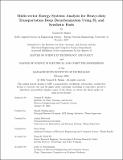Multi-vector Energy Systems Analysis for Heavy-duty Transportation Deep Decarbonization Using H₂ and Synthetic Fuels
Author(s)
Shaker, Youssef H.
DownloadThesis PDF (7.983Mb)
Advisor
Mallapragada, Dharik
Botterud, Audun
Terms of use
Metadata
Show full item recordAbstract
Policies focused on deep decarbonization of regional economies tend to emphasize electricity sector decarbonization in conjunction with electrification of end-uses and increasingly, on the use of hydrogen (H₂) produced via electricity for displacing fossil fuels in difficult-toelectrify sectors. One such use case is heavy-duty transport, which represents a substantial and growing share of global transport sector emissions given the increasing electrification of the light duty vehicle fleet. Here, we assess the bulk energy system impact of decarbonizing the heavy-duty vehicle (HDV) segment via use of either H₂ or drop-in synthetic liquid fuels produced from H₂ along with CO₂. Our analysis relies on soft-linking two modeling approaches: a) a bottom-up model of transportation energy demand that produces a variety of final energy demand scenarios for the same service demand and b) a multi-sectoral capacity expansion model, DOLPHYN, that co-optimizes power, H₂ and CO₂ supply chains subject to a variety of technological and policy constraints to meet the exogeneous final energy demand slate. Through a case study of Western European countries under deep decarbonization constraints for the year 2040, we quantify the energy system implications of varying levels of H₂ and synthetic fuels adoption in HDVs, under scenarios with and without CO₂ sequestration capacity availability. We find that substitution of liquid fossil fuels in the HDV segment is essential to meet the imposed deep decarbonization constraint across the modeled power, H₂, and transport sectors, particularly in the absence of CO₂ storage. Additionally, we find that utilizing H₂ HDVs reduces bulk system costs of deep decarbonization, while reducing fossil liquids demand, but could increase natural gas consumption in cases. While H₂ HDV adoption reduces the need for direct air capture (DAC), synthetic fuel adoption results in a greater need for DAC and also leads to system cost increases compared to scenarios without their adoption. The study highlights the trade-offs associated with different transportation decarbonization pathways, and underlines the importance of multi-sectoral consideration in decarbonization studies.
Date issued
2024-02Department
Massachusetts Institute of Technology. Department of Electrical Engineering and Computer Science; Massachusetts Institute of Technology. Institute for Data, Systems, and SocietyPublisher
Massachusetts Institute of Technology